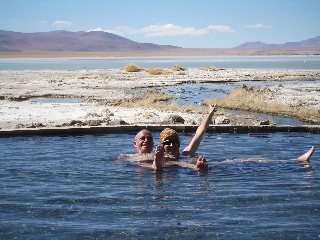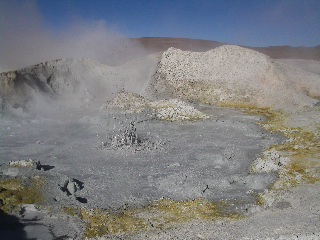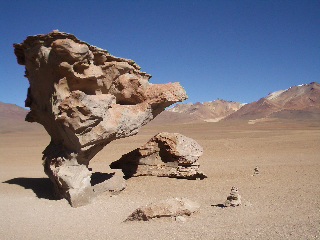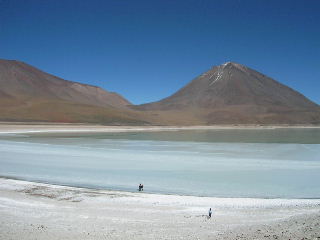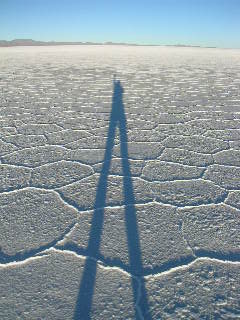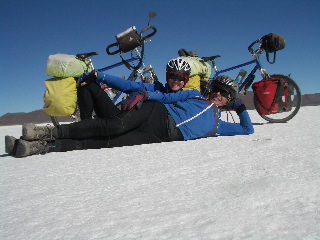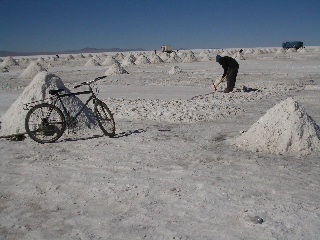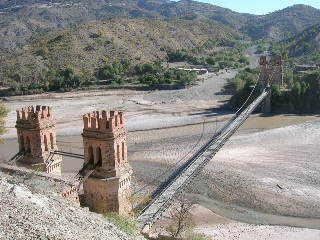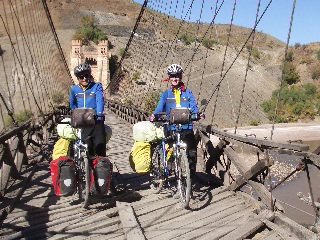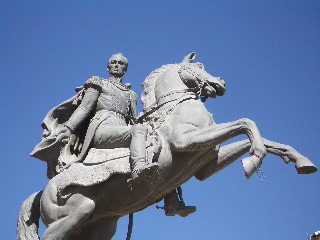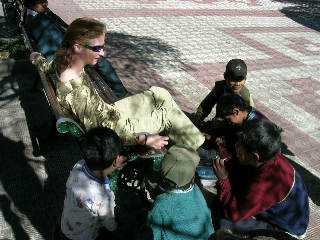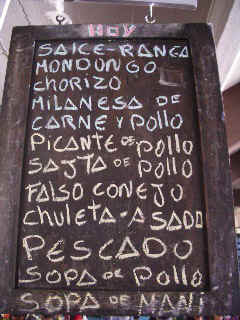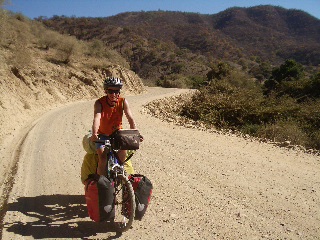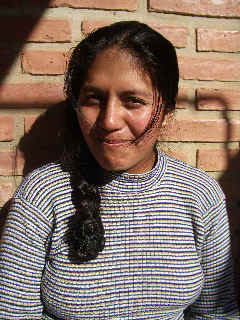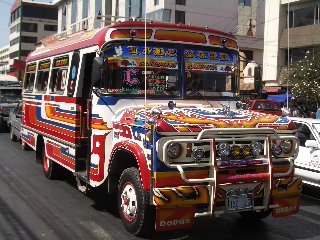|
|||
June
25 - July 28, 2006 |
|||
| To explore the National Reserve of Eduardo Avaroa, we opted for a jeep tour with Estrella del Sur in San Pedro, which we can highly recommend. | |||
| This
huge park in south west Bolivia is a spectacular bombardment of the senses
with lagoons in red, green, white and blue, bubbling mud pools, puffing
geysers, steaming hot pools, remarkable rock formations, shy vicuñas,
proud llamas, pink flamingoes, and very sandy tracks reaching altitudes of
5,000m.
|
|
||
 Geyser Sol de Mañana |
|
||
|
|||
 Flamingos on Laguna Coloroada |
|
||
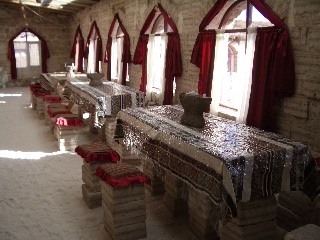 The Salt Hotel |
On
the second night we stayed in the Salt
Hotel in Atullcha. This friendly place is built entirely of salt
blocks; we sat on salt, walked on salt, slept on salt and ate off salt…
so anyone complaining of bland soup there, has only himself to blame!
|
||
| Back on the bikes, an hour-long sludge through a sandy, salty poppadom or fasnachtschuechli-like surface… and we were on the famous Salar de Uyuni. | |||
| This 12,000km2 (and growing) salt
lake is the world’s largest, and visible from the moon. In this season (winter)
it’s totally dry, and therefore the widest and whitest bicycle path on
earth! Its sparkling, dazzling and endless expanse looks like ice,
feels like ice… but tastes exactly like salt.
|
|
||
| Tiny cracks in the salt produce a tiled appearance on the surface…. Ideal for playing hop-scotch! | |||
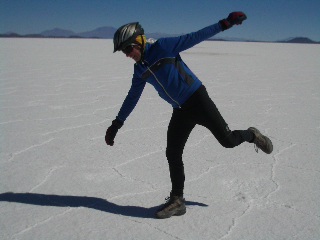 |
 |
||
Playing hop-scotch on the Salar de Uyuni! |
|||
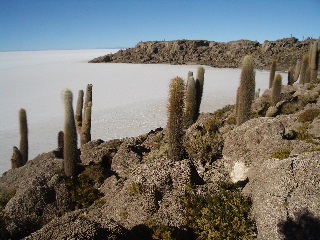 Incahuasi Island |
We
spent out first night on the gorgeous cactus Incahuasi
Island, where we felt like 5-star guests in their cosy refugio (hut) overlooking the salar.
Kurt is still bamboozled by this remote restaurant’s culinary
capabilities. On ordering llama filet, the waiter enquired if Roquefort sauce would be appreciated. Not only could he pronounce Roquefort,
but he even delivered!
|
||
| Another 60km later, we set up camp on this stunning white desert landscape. We made sure to be in our thermals, winter woollies and sleeping bags by sundown, when the temperature drops like a lead balloon. Minus 24 degrees Celsius is a tad on the fresh side, even for Eskimos like Darina! Waking up on July 1 in these unique surroundings was perfect for celebrating one year on the road. |
|
||
|
|
||
|
|||
| First
impressions of Bolivia are very positive. People seem to be very calm,
laid back, friendly and helpful. Their indigenous faces radiate peace and
warmth. The most amusing sight so far is the ladies’
traditional attire. Sporting thick wool pleated skirts, knitted
cardigans, knee high socks/leg warmers, skimpy sandals, long girlie plaits, and
colourful baby bundles tied to their backs… all topped off with a bowler
hat – these women are making a serious fashion statement!
|
|||
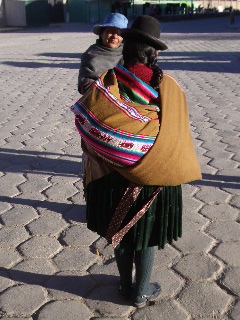 |
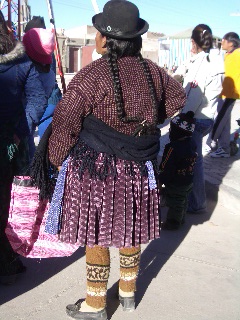 |
||
Bolivian Aymara ladies |
|||
For the next while we will be exploring the altiplano of Bolivia with altitudes remaining generally above 3,000m. We are happy to report that our breathlessness is now under reasonable control (with the help of coca tea) and we’re game for new adventures. |
|||
Uyuni’s
tourist information was extremely informative and gave us very good
advice on how best to leave this bitterly cold town i.e. on the bus! The
journey to Potosí, a mere 210km, took no less than six hours non-stop.
This gives
|
|||
| Potosí, the highest city in the world, is perched at 4,000m above sea level. This was yet another test for the lungs. Even just walking down the street was hard and it took us a couple of days to acclimatise. A colonial town of 150,000 today, Potosí was, in the 17th century, second only in size and prosperity to London. |
|
||
 Cerro Rico, Potosí |
On discovering
deposits of silver in the mountain towering above, the Spanish set up
camp in 1545 and started their exploitation of silver, native indians
and African slaves to earn their fortunes. |
||
Cerro Rico (Rich Mountain) was quite the mine and even 500 years later, there are
still 12,000 working there daily, in the knowledge that there is still
another 10 years of tin, lead, silver and gold to be dug out. The
frightening reality is that the miners' working conditions haven't
improved at all in the interim period. |
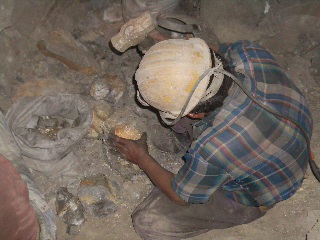 |
||
 |
We took a tour
down the mine and spent three hours underground in the complete darkness,
at temperatures of up to 40 degrees Celsius, coughing and choaking in
the dust, at reduced oxygen levels. At times we had to slither like snakes
in very confined tunnels to drop another level. There we would find
miners from the age of twelve, in totally inhumane conditions, hacking
holes in the wall and hammering at rocks to grade their mineral content. |
||
A typical working
day is eight hours with
no lunch break. We brought presents of CocaCola, coca leaves...
and dinamite! The miners chew coca leaves to suppress appetite and
sustain their bodies at this high altitude. After four hours in the
mouth, coca leaves go bland and so when the second mouth full becomes
tasteless, the miners know their day's work is done. The local answer to
a modern Rolex! |
Playing with dinamite! (Notice the coca ball in left cheek) |
||
They
work 6 days a week, for no more than 3 euros a day. Some of the men we
spoke to had a wife and 6 kids to feed back home. Their life expectancy
is around 50 and most are quickly scarred with silicosis and TB. 90% of
the miners endure such conditions merely because there are no
alternatives in the area. What will become of these 12,000 miners and
their families in 10 years time, when all the minerals are depleted? |
|||
It was definitely
not the most pleasant tour we have done, but certainly the most
impressive. Koala tour guides are all ex-miners and give great
insight into the real story of Cerro Rico. |
|
||
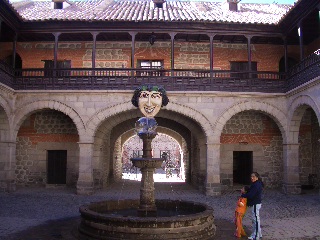 La Casa de la Moneda, Potosí |
The Casa de
la Moneda (the mint) in Potosí is an attraction well worth
visiting. Here the silver from the mines was cast into coins for the
whole Spanish Empire. On display are numerous original hammered coins
that managed to avoid the thievish hands of Sir Francis Drake. A lot of
the riches from Cerro Rico were amassed by the clergy and
transformed into elaborate churches and colonial buildings, making
Potosí a delightful tourist destination. |
||
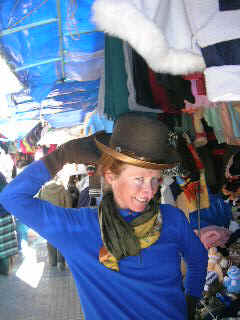 What do you reckon? |
|
||
|
|||
The road to Sucre
was a welcome change: tarmac. The 2-day journey included a phenomenal
downhill, followed by almost as phenomenal uphills all the way to Sucre. |
|
||
After
100km we decided to stop at Millares for the night. Alas, the pensiones (guest houses)
were no longer offering accommodation, so everyone sent us down to the
local hospital. It seemed a strange suggestion, but was chorused by all
en route, much to the dismay of the doctor in residence. It obviously
wasn't the first time... but he still didn't have any beds to offer! Carlos and Marta, his friendly neighbours, came to the rescue and opened
up their newly-built holiday home for us, while they returned to Potosi.
One week later the favour was extended to Liam and Claire and again to
Tim and Alain, making their house quite the Casa de Ciclistas.
Many thanks for such wonderful Bolivian hospitality! |
|||
 On the road to Sucre |
Soft rolling hills
with very deep cut valleys, where the river bed took up all the available
space below, provided the scenery on this stretch. Trees were sporting
autumn hues and the rocks varied from rusts to greys. |
||
We had a double
take when we came across a magnificent medieval-style suspension bridge
in the middle of nowhere. Branches and planks strapped together formed
our bumpy, but exciting, alternative crossing. |
|
||
|
|||
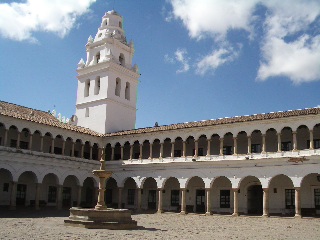 The Law Dept, University of Sucre |
Sucre, a
pretty colonial town of white-washed houses and red-tiled roofs is quite
reminiscent of Andalucia, Spain. It is considered to be the birthploace
of the Republic of Bolivia because the Declaration of Independence was
signed there. Today it is Bolivia's constitutional capital. |
||
After 300 years of
colonisation, the Spaniards were finally driven out of Bolivia in 1825.
This departure was brought about by 2 famous Venezuelan liberators,
who presently give their names to the country, a city and numerous
streets: Bolivar and Sucre. The Casa de la Libertad in Sucre
recounts their numerous exploits on the road to liberation. |
|
||
|
|||
It was a great
place to while away the time, visiting churches; not forgetting our
daily expedition to the market. It took us a whole week to eat our way
through the varied menu of soups and main courses. Amazingly, we could
eat our fill for about 0.75 euros. |
|
||
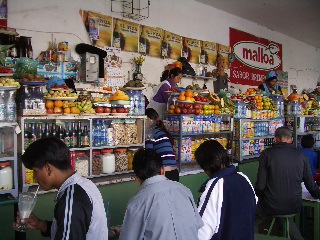 Fruit salad and juice stalls |
Then we had to
visit our fruit/juice dealers for delicious freshly-made exotic fruit
salads with yoghurt, and frothy milk shakes. |
||
Breakfast at the
market is usually Api (a hot, quinua cereal drink) with fried
bread, which comes to the grand total of 10 cents per person! |
|
||
 Viscacha |
Soups are a meal
in themselves with meat, veg and rice in a well, flavoured stock. Our variety of meat has also extended to the exotic with llama and vizcacha (rabbit-like animal) stews. |
||
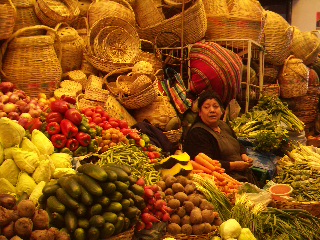 |
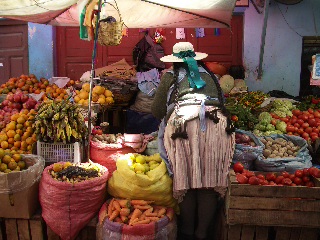 |
||
Market scenes |
|||
In 1994, in the local cement factory, some strange tracks were discovered on a wall.
Further investigation revealed that this was a pre-historic soccer field
where Titanosaurius Utd. played Tiranosaurus FC in the cup final.
Argentine and Brazilian archaelogists still dispute the final result of
this deciding game! |
|
||
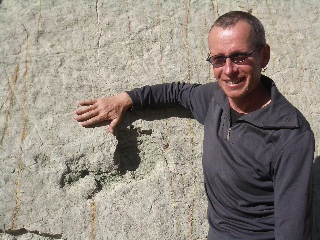 He was a big one! |
With the collision
of two tectonic plates, these dinosaur tracks, from 65 million
years ago, were pushed into a vertical position, and later exposed by explosions
at
the cement factory. Reaching up to 25m in size, these herbivores and
carnivores were quite the monsters, and probably more suited to
basketball! |
||
|
|||
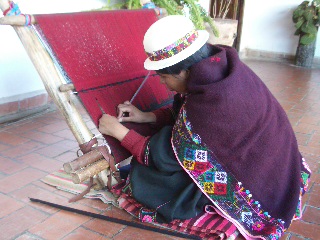 Weaving ad-lib |
The Indigenous
Art museum has a fantastic display of unique textiles depicting
everything from domestic and agricultural scenes to your worst, scary
nightmares. Woven without patterns, it is fascinating to watch how the
weavers create such intricate, non-symetrical designs out of their heads,
even without the help of LSD! |
||
The road to
Cochabamba had all the features of shake, rattle and roll.
A relay of able-bodied boys and men cheerfully pushed us both up the
final hill of Sucre which made for a very animated departure. From there
we rolled about 90km down hill, on a grand cement surface, to the
border with the Cochabamba province. This was where the aspect of shake was dominant in the form of landslides, that oftentimes blocked half the
road. |
|
||
|
Then followed our
beloved ripio (gravel) road, which was actually on the better side
of bad! Ascending a hill out of one of the friendly villages, a local
one-legged 18-year old zoomed past us on his bike with a triumphant
smile plastered all over his face. Unfortunately he wasn't at all
interested in lugging our load up to the next pass. Smart lad! |
||
We returned from
lunch in a restaurant, only to discover that our bikes had reproduced in
our absence! |
|
||
 Poisonous coral snake |
And look what just
slithered out from under a stone among the thorns at our wild campsite... |
||
From the once
lovely colonial village of Aiquile, destroyed by an earthquake in 1998,
it was rattle all the way. Cobblestones took over with a
vengeance and we got to ride the narrowest bike lane in the world! This
being the 8cm cement border between the rugged surface of the stone road
and the drop off to the thorn-laiden dust margin. Quite the circus act
at times... but our 9 punctures in the space of 3 hours are evidence of
our failure as tight-rope cyclists!!! |
|
||
|
This was the straw that broke the camel's back and after 2 days of cobblestones, we jumped on a bus to the start of the tarmac stretch, a good day's roll from Cochabamba. | ||
| We camped a lot en route, and even had the use of a health centre's kitchen and bathroom, thanks to Rosmary. The weather on this stage was a whole lot more pleasant. Even though it's winter here, we have been enjoying 25 degrees Celsius during the day since we dropped from 4,000m. |
|
||
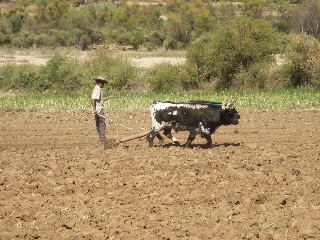 Combined harvester, Misque |
|
||
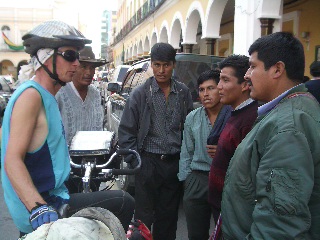 Welcome to Cochabamba! |
25km out of Cochabamba,
Kurt noticed a crack on his rear rim. Luckily it held all the way into
the city where he found a replacement that fits in both size and colour.
After 16,000km, it was also time to replace Darina's front Maxxis
Overdrive tyre and front hub ball-bearings... all of which was
painless with the numerous stalls and workshops in the central market
area. |
||
Here in
Cochabamba, Darina took some time out to busy herself on the toilet and
is singing the praises of an en suite bathroom to save crucial Kms.
Meanwhile, Kurt got his visa extension (Swiss get 30 days, as opposed to
90 days for EU members): a process which involved queueing at 4
different counters for 2 days, half-a-forest worth of paperwork and a
whole lot of anger management *%$X&/*!!!! |
|
||
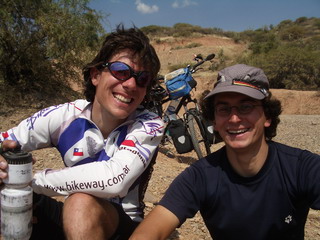 Alain and Felix |
Felix (German) and
Alain (Swiss) from Salta days, have caught up with us again and we're
all headed towards La Paz on the weekend. It's been a month of few, but
strenuous Kms, and a lot of cultural exploration and chill-out time, to
blend in with the relaxed local pace! |
||
| Previous (Chile/Argentina) See Map Next (Bolivia) | |||
.jpg)
